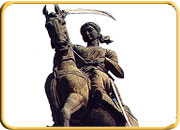Jhansi
Jhansi
 Maharaja
Chattrasal Bundela of Panna was a good administrator and a brave warrior. In
1729 Mohammed Khan Bangash attacked Chattrasal. Peshwa Baji Rao(I ) helped Maharaja
Chattrasal and defeated mughal army. As a mark of gratitude Maharaja Chattrasal
offered a part of his state to Maratha Peshwa Baji Rao(I). Jhansi was also included
in this part.
Maharaja
Chattrasal Bundela of Panna was a good administrator and a brave warrior. In
1729 Mohammed Khan Bangash attacked Chattrasal. Peshwa Baji Rao(I ) helped Maharaja
Chattrasal and defeated mughal army. As a mark of gratitude Maharaja Chattrasal
offered a part of his state to Maratha Peshwa Baji Rao(I). Jhansi was also included
in this part.In 1742 Naroshanker was made the subedar of Jhansi. During his tenure of 15 years he not only extended the Jhansi fort which was of strategic importance but also constructed some other buildings. The extended part of the fort is called Shankergarh. In 1757 Naroshanker was called back by the Peshwa. After him Madhav Govind Kakirde and then Babulal Kanahai were made the subedars of Jhansi.
In 1766 Vishwas Rao Laxman was made the subedar of Jhansi. His period was from 1766 to 1769. After him Raghunath Rao (II) Newalkar was appointed the subedar of Jhansi. He was a very able administrator. He increased the revenue of the state. The MahaLakshmi Temple and the Raghunath Temple were built by him. For his own residence he constructed a beautiful building Rani Mahal in the city. In 1796 Raghunath Rao passed the subedari in favour of his brother ShivRao Hari. After the death of Shiv Rao his grand son Ramchandra Rao was made subedar of Jhansi. He was not a good administrator. Ramchandra Rao died in 1835. After his death Raghunath Rao (III) was made his successor. In 1838 Raghunath Rao (III) also died. The British rulers then accepted Gangadhar Rao as the Raja of Jhansi. Due to the inefficient administration during the period of Raghunath Rao (III) the financial position of Jhansi was very critical.
Raja Gangadhar Rao was a very good administrator. He was very generous and full of sympathy. He gave very good administration to Jhansi. During his period the local population of Jhansi was very satisfied.
In 1842 Raja Gangadhar Rao married Mannikarnika. After this marriage Mannikarnika was given the new name Lakshmi Bai, who led forces against British in 1857. She sacrificed her life to the cause of Indian Independence in 1858.
In 1861 the British Government gave the Jhansi fort and Jhansi city to JiyajiRao Scindia. Jhansi was then became a part of Gwalior state. In 1886 Britishers took back Jhansi from Gwalior state.
Select a holiday with us